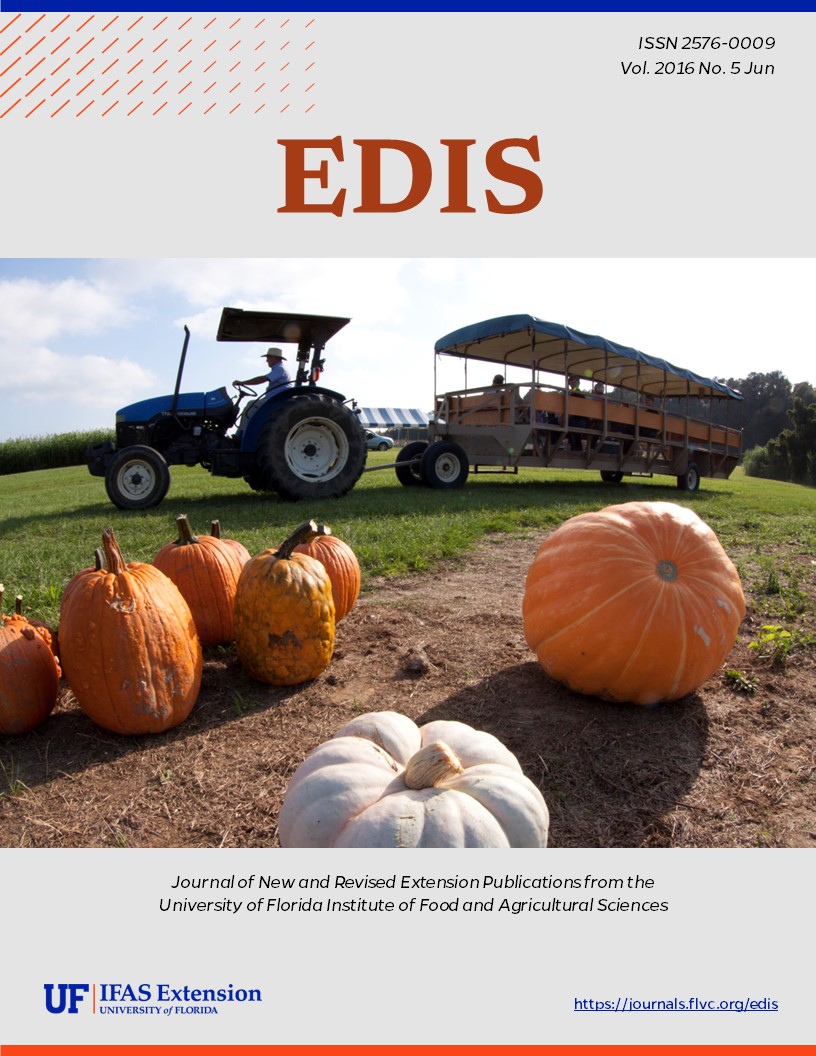Abstract
The growing olive industry in the southeastern United States, including Florida, lacks specific fertilization guidelines due to limited region-specific research. Existing recommendations from other regions guide current practices. This guide outlines nutrient management for olive trees, assuming a density of 600 trees per acre. Fertilization should be uniformly distributed within the tree’s dripline, integrating soil and plant tissue sampling to inform nutrient needs, particularly using leaf tissue analysis for accurate in-season nutrient assessment. Nutrient recommendations primarily address nitrogen (N), phosphorus (P), potassium (K), and boron (B), with specific protocols for leaf tissue sampling and sufficiency ranges. Challenges in Florida include rapid leaching of B and K in sandy soils and the risk of excessive irrigation. This guide highlights the need for ongoing research to develop Florida-specific best management practices for olive production. Additional resources on olive cultivation in Florida are provided.
References
Beutel, J., K. Uriu, and O. Lilleland. 1983. "Leaf analysis for California deciduous fruits." Soil and Plant Tissue Testing in California Bulletin 1879. Division of Agricultural Sciences, University of California.
Boulal, H., L. Sikaoui, and M. El Gharous. 2013. "Nutrient management: A new option for olive orchards in North Africa." Better Crops with Plant Food 97: 21–22.
Bryson, G. M., and H. A. Mills. 2014. Plant Analysis Handbook IV. Athens: Micro-Macro Publishing.
Chatzissavvidis, C. A., I. N. Therios, and C. Antonopoulou. 2004. "Seasonal variation of nutrient concentration in two olive (Olea europaea L.) cultivars irrigated with high boron water." J. Horticult. Sci. Biotechnol. 79: 683–688.
Connell, J. H., and P. M. Vossen. 2007. "Organic olive orchard nutrition." In Organic Olive Production Manual, ed. P. M. Vossen (Oakland: University of California, Agricultural and Natural Resources, Communication Services), 107.
Fernández-Escobar, R., M. Parra, C. Navarro, and O. Arquero. 2009. "Foliar diagnosis as a guide to olive fertilization." Spanish Journal of Agricultural Research 7: 212–223.
Gillett-Kaufman, J. L., S. A. Allen, J. H. Bosques-Mendez, and L. J. Buss. 2014. Pests and Fungal Organisms Identified on Olives (Olea europaea) in Florida. IN1046. Gainesville: University of Florida Institute of Food and Agricultural Sciences. https://edis.ifas.ufl.edu/in1046
Hansen, C. 1945. "Boron content of olive leaves." Proceedings of the American Society for Horticultural Science 46: 78–80.
Hartmann, H. 1958. "Nitrogen fertilizers on olive: Response to nitrogen applications apparently influenced by variable factors found in different olive growing districts." Calif. Agric. 12: 6–7.
Hochmuth, G., D. Maynard, C. Vavrina, E. Hanlon, and E. Simonne. 2015. Plant Tissue Analysis and Interpretation for Vegetable Crops in Florida. EP081. Gainesville: University of Florida Institute of Food and Agricultural Sciences. https://edis.ifas.ufl.edu/ep081
Hochmuth, G., R. S. Mylavarapu, and E. Hanlon. 2014. Soil Testing for Plant-Available Nutrients—What Is It and Why Do We Use It? SS621. Gainesville: University of Florida Institute of Food and Agricultural Sciences. https://edis.ifas.ufl.edu/ss621
Kissel, D. E., and G. Harris. 2015. "Field crops." University of Georgia. Accessed March 24, 2016. http://aesl.ces.uga.edu/publications/soil/cropsheets.pdf
Marín, L., and R. Fernández-Escobar. 1996. "Optimization of nitrogen fertilization in olive orchards." III International Symposium on Mineral Nutrition of Deciduous Fruit Trees 448: 411–414.
Mylavarapu, R. 2010. "Diagnostic nutrient testing." HortTechnology 20: 19–22.
Mylavarapu, R. S., T. A. Obreza, Morgan, K. T., G. J. Hochmuth, V. D. Nair, and A. L. Wright. 2017. Extraction of Soil Nutrients Using Mehlich-3 Reagent for Acid-Mineral Soils of Florida. SL407. Gainesville: University of Florida Institute of Food and Agricultural Sciences. https://edis.ifas.ufl.edu/ss620
Rodrigues, M. Â., I. Q. Ferreira, A. M. Claro, and M. Arrobas. 2012. "Fertilizer recommendations for olive based upon nutrients removed in crop and pruning." Scientia Horticulturae 142: 205–211.
Rodrigues, M. Â., F. Pavão, J. I. Lopes, V. Gomes, M. Arrobas, J. Moutinho-Pereira, S. Ruivo, J. E. Cabanas, and C. M. Correia. 2011. "Olive yields and tree nutritional status during a four-year period without nitrogen and boron fertilization." Commun. Soil Sci. Plant Analysis 42: 803–814.
Sibbett, G. S., L. Ferguson, and M. Lindstrand. 2005. Olive Production Manual. Oakland: UCANR Publications.
Shorrocks, V.M. 1997. "The occurrence and correction of boron deficiency." Plant Soil 193: 121–148.
Thetford, M., J. L. Gillett-Kaufman, and M. J. Mulvaney. 2015. Olives for Your Florida Landscape. EP515. Gainesville: University of Florida Institute of Food and Agricultural Sciences. https://edis.ifas.ufl.edu/ep515
Tsadilas, C. D. 2004. "Diagnosis, prediction and control of boron deficiency in olive trees." In Production Practices and Quality Assessment of Food Crops, ed. R. Dris and S. M. Jain (Dordrecht: Kluwer Academic), 129–137.
Vossen, P. M. 2006. "Fertility management for oil olives." First Press 3: 1–2. Accessed March 24, 2016. http://cesonoma.ucanr.edu/files/27222.pdf
Vossen, P. M., K. M. Klonsky, and R. L. DeMoura. 2001. "Sample costs to establish an olive orchard and produce olive oil." Department of Agricultural and Resource Economics OO-CC-01: 21.
White, T. 1984. "The abundance of invertebrate herbivores in relation to the availability of nitrogen in stressed food plants." Oecologia 63: 90–105.

This work is licensed under a Creative Commons Attribution-NonCommercial-NoDerivatives 4.0 International License.
Copyright (c) 2016 UF/IFAS

